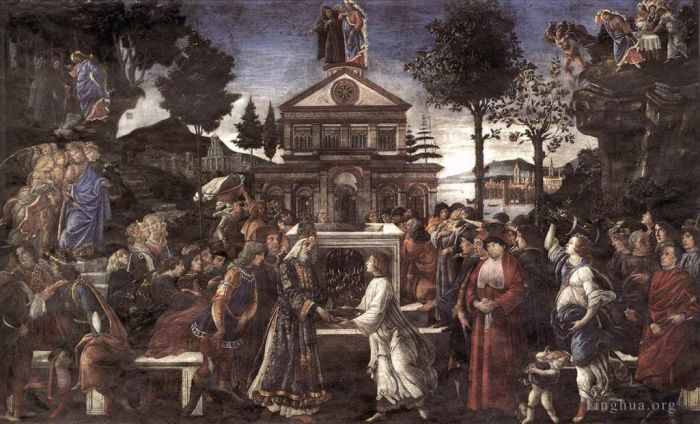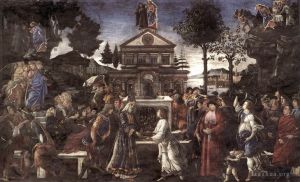The Temptation of Christ
Sandro Botticelli
- Price: Price on Request
- Art Type: Various Paintings
- Size:
- English Comments: 0
- International Comments: 0
- Creating Date:
- Introduction and Works of Sandro Botticelli >>
Keywords:
Temptation, Christ
Work Overview
- The Temptations of Christ
Artist Sandro Botticelli
Year 1480–1482
Type Fresco
Dimensions 345.5 cm × 555 cm (136.0 in × 219 in)
Location Sistine Chapel, Rome
The Temptations of Christ is a fresco by the Italian Renaissance painter Sandro Botticelli, executed in 1480–1482 and located in the Sistine Chapel, Rome.
On 27 October 1480 Botticelli, together with other Florentine painters, Domenico Ghirlandaio and Cosimo Rosselli, left for Rome, where he had been called as part of the reconciliation project between Lorenzo de' Medici, the de facto ruler of Florence, and Pope Sixtus IV. The Florentines started to work in the Sistine Chapel as early as the Spring of 1481, along with Pietro Perugino, who was already there.
The theme of the decoration was a parallel between the Stories of Moses and those of Christ, as a sign of continuity between the Old and the New Testament. A continuity also between the divine law of the Tables and the message of Jesus, who, in turn, chose Peter (the first bishop of Rome[1]) as his successor: this would finally result in a legitimation of the latter's successors, the popes of Rome.
Botticelli, helped by numerous assistants, painted three scenes. On 17 February 1482 his contract was renovated, including the other scenes to complete the chapel's decoration. However, on 20 February, his father died: he returned to Florence, where he remained.
The Temptations of Christ depicts three episodes from the gospels, in parallel with the painting on the opposite wall, also by Botticelli, showing the Trials of Moses. A frieze, similar to that beneath the other frescos, has the inscription TEMPTATIO IESU CHRISTI LATORIS EVANGELICAE LEGIS ("The Temptations of Christ, Bringer of the Evangelic Law").
The subject of the title takes place in three scenes in the upper section of the fresco. On the left, Jesus, who has been fasting, is tempted by the Devil, in the guise of a hermit, to turn stones into bread. In the second scene of temptation, at the upper centre of the picture, the Devil has carried Jesus to the top of the temple of Jerusalem, represented by the facade of the Chapel of Santa Maria in Traspontina of the Church of Santo Spirito in Sassia in Rome. The Devil tempts Jesus to challenge God's promise that he will be protected by angels, by throwing himself down. In the third temptation, to the upper right, the Devil has taken Jesus to a high mountain where he shows him the beauties of the Earth. The Devil promises Jesus power over this domain, if he will deny God and bow down to the Devil. Jesus sends the Devil away from him, while angels come to minister to him.
In the foreground, a man whom Jesus has healed of leprosy presents himself to the High Priest at the temple, so that he may be pronounced clean. The young man carries a basin of water, in which is a bough of hyssop. A woman brings two fowls for sacrifice and another woman brings cedar wood. These three ingredients were part of the ritual of cleansing of a leper. The high priest may symbolize Moses, who transmitted the Law, and the young man may symbolically represent Christ, who, according to the Gospels, was wounded and slain for the benefit of mankind, and healed through the Resurrection so that mankind might also be made spiritually clean, and receive salvation. In Christian symbolism, many stories, such as the healing of the leper, are perceived to prefigure the crucifixion and resurrection of Jesus, or other events in his life.
The fresco is from the cycle of the life of Christ in the Sistine Chapel. It is located in the second compartment on the north wall.
The fresco which Botticelli began in July, 1481, is the third scene within the Christ cycle and depicts the Temptation of Christ. Christ's threefold temptation by the Devil, as described in the Gospel according to Matthew, can be seen in the background of the picture, with the devil disguised as a hermit. At top left, up on the mountain, he is challenging Christ to turn stones into bread; in the centre, we see the two standing on a temple, with the Devil attempting to persuade Christ to cast himself down; on the right-hand side, finally, he is showing the Son of God the splendour of the world's riches, over which he is offering to make Him master. However, Christ drives away the Devil, who ultimately reveals his true devilish form. On the right in the background, three angels have prepared a table for the celebration of the Eucharist, a scene which only becomes comprehensible when seen in conjunction with the event in the foreground of the fresco. The unity of these two events from the point of view of content is clarified by the reappearance of Christ with three angels in the middle ground on the left of the picture, where He is apparently explaining the incident occurring in the foreground to the heavenly messangers. We are concerned here with the celebration of a Jewish sacrifice, conducted daily before the Temple in accordance with ancient custom. The high priest is receiving the blood-filled sacrificial bowl, while several people are bringing animals and wood as offerings.
At first sight, the inclusion of this Jewish sacrificial scene in the Christ cycle would appear extremely puzzling; however, its explanation may be found in the typological interpretation. The Jewish sacrifice portrayed here refers to the crucifixion of Christ, who through His death offered of His flesh and blood for the redemption of mankind. Christ's sacrifice is reconstructed in the celebration of the Eucharist, alluded to here by the gift table prepared by the angels.
After his baptism Jesus spends 40 days in the wilderness, fasting. The devil asks him to turn stone into bread, thereby proving that he is the son of God. Jesus refuses: But he answered and said: It is written: 'Man shall not live on bread alone, but on every word that proceeds out of the mouth of God.'
That story is depicted top left. In the top center the devil and Jesus stand on the roof of a temple. The devil challenges Jesus to let himself fall: surely he will be caught by angels. On the right the two are on a high cliff. The devil offers Jesus all kingdoms in the world.
The main part of the fresco shows an offering. It probably is the sacrifice the leper offered after he was healed by Jesus (Matthew 8:3).
On the opposing wall Botticelli made his fresco with Scenes from the Life Of Moses.
Botticelli and several assistants completed the fresco known as the Temptations of Christ in 1482 after almost 2 years of labor. The work was part of the Sistine Chapel project at the Vatican, and his portion was requested by Pope Sixtus and Lorenzo de’Medici in a joint effort of reconciliation.
What is the Painting About?
The painting was based on a specific theme proposed by the commissioners having to do with the similarities between the stories of Christ and of Moses, and between the old laws and the new law put forward by Christ, all of which also demonstrated the connection between the New and Old Testaments. This theme echoed the idea of reconciling the Vatican and civil powers in Rome.
Composition
Depicted in the upper section of the fresco are three scenes taken from the life of Jesus in the Gospels. The upper left episode is a meeting between the devil, in the guise of a hermit, and Christ. The upper center panel depicts the two characters struggling over a temple, and the scene on the right has Satan being overthrown from a high rocky place. In the foreground the painter has composed a scene of a sacrificial ritual in which the younger male figure stands for Christ and the priestly figure for Moses. The overall effect of the work is that it is busy with action and crowded with many persons, and each detail tells a story. The background is a mountainous landscape, and the colors are primary, brilliant, and fresh (typical of frescoes in this style).
- Copyright Statement:
All the reproduction of any forms about this work unauthorized by Singing Palette including images, texts and so on will be deemed to be violating the Copyright Laws.
To cite this webpage, please link back here.
- >> English Comments
- >> Chinese Comments
- >> French Comments
- >> German Comments
- >>Report
- Pallas and the centaur
- The Calumny of Apelles
- Killing the woman (The Story of Nastagio degli Onesti - second episode)
- Nastagio meets the woman and the knight in the pine forest of Ravenna (The Story of Nastagio degli Onesti - first episode)
- The Birth Of Venus
- Primavera
- Discovery of murder Holophernes
- The banquet in the forest (The Story of Nastagio degli Onesti - third episode)
- Madonna And Child With An Angel 2
- Sandro Portrait of a young man
- Portrait of a young man
- Madonna In Glory With Seraphim
- The Temptation of Christ
- The Discovery Of The Murder Of Holofernes
- The Cestello Annunciation
- Adoration of The Magi
- Madonna della Loggia (Madonna and Child)
- Marriage of Nastagio degli Onesti (The Story of Nastagio degli Onesti - fourth episode)
- The Trials of Moses (The Youth of Moses)
- Madonna and Child with Six Saints (Sant Ambrogio Altarpiece)
- Portrait of a young man 1483
- Madonna And Child With An Angel
- Portrait of an young woman
- Venus and Mars
- Punishment of the Rebels (The Punishment of the Sons of Corah)
- Adoration Of The magi
- Madonna of the Rose Garden
- Simonetta
- Virgin and Child with an Angel (Our Lady of the Eucharist)
- Madonna And Child And Two Angels
- The Return Of Judith To Bethulia
- The Mystical Nativity
- Fortitude
- Sixtus II
- Guliano de Medici
- Madonna of the Book (The Virgin and Child)
- The Virgin And Child With Two Angels
- Madonna of The Magnificat
- Madonna with Child and five angels (The Virgin and Child surrounded by Five Angels)









 Singing Palette
Singing Palette